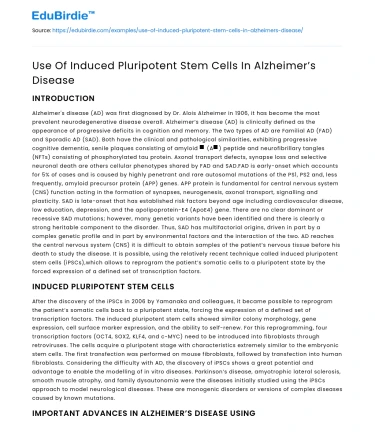INTRODUCTION
Alzheimer's disease (AD) was first diagnosed by Dr. Alois Alzheimer in 1906, it has become the most prevalent neurodegenerative disease overall. Alzheimer’s disease (AD) is clinically defined as the appearance of progressive deficits in cognition and memory. The two types of AD are Familial AD (FAD) and Sporadic AD (SAD). Both have the clinical and pathological similarities, exhibiting progressive cognitive dementia, senile plaques consisting of amyloid β (Aβ) peptide and neurofibrillary tangles (NFTs) consisting of phosphorylated tau protein. Axonal transport defects, synapse loss and selective neuronal death are others cellular phenotypes shared by FAD and SAD.FAD is early-onset which accounts for 5% of cases and is caused by highly penetrant and rare autosomal mutations of the PS1, PS2 and, less frequently, amyloid precursor protein (APP) genes. APP protein is fundamental for central nervous system (CNS) function acting in the formation of synapses, neurogenesis, axonal transport, signalling and plasticity. SAD is late-onset that has established risk factors beyond age including cardiovascular disease, low education, depression, and the apolipoprotein-E4 (ApoE4) gene. There are no clear dominant or recessive SAD mutations; however, many genetic variants have been identified and there is clearly a strong heritable component to the disorder. Thus, SAD has multifactorial origins, driven in part by a complex genetic profile and in part by environmental factors and the interaction of the two. AD reaches the central nervous system (CNS) it is difficult to obtain samples of the patient’s nervous tissue before his death to study the disease. It is possible, using the relatively recent technique called induced pluripotent stem cells (iPSCs),which allows to reprogram the patient’s somatic cells to a pluripotent state by the forced expression of a defined set of transcription factors.
INDUCED PLURIPOTENT STEM CELLS
After the discovery of the iPSCs in 2006 by Yamanaka and colleagues, it became possible to reprogram the patient’s somatic cells back to a pluripotent state, forcing the expression of a defined set of transcription factors. The induced pluripotent stem cells showed similar colony morphology, gene expression, cell surface marker expression, and the ability to self-renew. For this reprogramming, four transcription factors (OCT4, SOX2, KLF4, and c-MYC) need to be introduced into fibroblasts through retroviruses. The cells acquire a pluripotent stage with characteristics extremely similar to the embryonic stem cells. The first transfection was performed on mouse fibroblasts, followed by transfection into human fibroblasts. Considering the difficulty with AD, the discovery of iPSCs shows a great potential and advantage to enable the modelling of in vitro diseases. Parkinson’s disease, amyotrophic lateral sclerosis, smooth muscle atrophy, and family dysautonomia were the diseases initially studied using the iPSCs approach to model neurological diseases. These are monogenic disorders or versions of complex diseases caused by known mutations.
Save your time!
We can take care of your essay
- Proper editing and formatting
- Free revision, title page, and bibliography
- Flexible prices and money-back guarantee
IMPORTANT ADVANCES IN ALZHEIMER’S DISEASE USING iPSCs
Using iPSCs allowing a better understanding of cellular and molecular target. One of the studies involving iPSCs generated for AD were carried out in 2011 by Yahata et al., and Yaqi et al. Yahata et al., successfully generated forebrain neurons from human iPSCs cells, and showed that Aβ production in neuronal cells was detectable and inhibited by some typical secretase inhibitors and modulators. According to the authors, hiPSCs cell-derived neuronal cells express functional β- and γ-secretases involved in Aβ production. Anti-Aβ drug screening using these hiPS cell-derived neuronal cells requires sufficient neuronal differentiation. Also, Yaqi et al. generated iPSCs from fibroblasts of FAD patients with mutations in PS1 and PS2 and characterized the differentiation of these cells into neurons. They demonstrated that patient-derived differentiated neurons have increased Ab42 secretion, recapitulating the pathological mechanism of FAD with PS1 and PS2 mutations. These two studies represent, thus, critical first steps in assessing the potential of AD iPSCs to model AD. iPSCs is a pre-clinical tool for screening therapeutic compounds. The approach is central to toxicity and efficacy testing, in the new drug development landscape and the precise engineering of the genome and transcriptional and proteomic analysis.
FUTURE CONCERN
With the advance of research using the iPSCs, the customization of the treatment for patients with AD is possible, reaching new insights associated with the pathogenesis and discovery of new drugs for the treatment. At present, we can model in vitro diseases to allow patient-specific therapies from newly derived AD-iPSCs to be used by considering the appropriate characterization of AD patient groups through genetic profiles and biomarkers. In iPSCs, we can highlight the level of maturity of the neurons, lack of efficient protocols to generate microglia, and few protocols of 3D differentiation that appropriately mimic the in vivo environment of the brain . To generate and differente iPSCs are still a time-consuming and expensive processes. iPSCs can be used from an individual to direct their appropriate treatment through personalized medicine, improving the patient’s life. During the formation of iPSCs, there are a concern about introducing harmful mutations. Therefore, new genome editing techniques, such as the clustered regularly interspaced short palindromic repeats (CRISPR)-associated protein 9 (Cas9) nuclease system, reduce the risk of introduction and spread of undesired mutations.
APPLICATION OF iPSC IN ALZHEIMER’S DISEASE
In light of the important benefits conferred by their self-renewal and multidirectional differentiation capacity, iPSCs are valued in the context of regenerative medicine and disease modeling, especially for neurodegenerative disorder. iPSCs is a relevant tool to study the fundamental etiology of neurological diseases and also perform high-throughput drug screening for CNS disorders. In fact, several neurological diseases have been modeled using iPSCs, such as monogenic disorders and versions of complex diseases caused by known mutations have been modeled by iPSCs. Similarly, AD is another slow progressing disease with a poorly understood etiology and a lack of efficient therapeutic strategies.






 Stuck on your essay?
Stuck on your essay?

